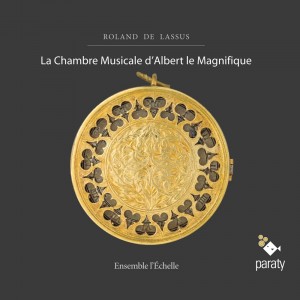
1555 was a memorable date in the Spanish Low Countries, marked by the abdication of the Emperor Charles V in favour of his son Philippe, an event which provoked surprise and disbelief throughout the western world. The same year also saw a cultural event of some importance –the first publication of a collection of polyphonic music, by Tylman Susato in Antwerp, composed by a young composer full of ambition and talent, which one might call his Opus 1. His name as given on the title page, “Rolando di Lassus”, gives a clue as to the european dimension of this native of Hainaut, whose French-speaking parents no doubt christened Roland, but whose years spent in Italy, between the ages of 13 and 23, had changed his name to Orlando di Lasso; his reputation having being made with this name, he retained it all his life, even in Bavaria where he was to spend the rest of his life.
Duke Albert V of Bavaria was, in that same year of 1555, busy acquiring the best singers for his chapel. This sovereign, a great friend of the arts if somewhat spendthrift, had asked the Vice-Chancellor of the court in Vienna, no less, to find him singers in Flanders, for Flemish singers were renowned to be the best in Europe. And so it was that the young Lassus, who after two years of searching had not managed to find a secure position with a powerful institution or person in Flanders, despite the publication (in 1556) of a second collection, the “Antwerp book of motets”, accepted a post at the court of the Duke of Bavaria as a tenor, no doubt after a certain amount of hard bargaining.
Albert V, of the family Wittelsbach, married to Anna of Hapsburg (Anna von Österreich), Charles V’s niece – the families were traditional allies – had come to power six years previously. When Lassus arrived, the couple had already produced five children, including three boys. William (Wilhelm), the eldest at eight years old, was next in line to the throne, and his brothers Ferdinand and Ernest (Ernst) would, following unchangeable tradition, make their careers either in the army or the church (Ernest was made a bishop at the age of 12, and became Archbishop of Cologne in 1583). Their father, fascinated by the splendour of the Italian courts in which he had passed much of his youth, was set upon making his own shine with the same brilliance in all aspects of culture, the arts, literature and, of course, music. The arrival of Lassus not only marked the acquisition of an excellent singer, one moreover destined to replace the current Kapellmeister (which came about in 1562), but also a composer of some reputation, able to respond (and with what speed and fecundity!) with both liturgical and occasional works to the needs of all kinds of celebrations. For example, the motet Cernere virtutes is an epithalamium composed in 1557 for the marriage of Albert V’s sister, the princess Matilda (Mechtilde), to the Margrave Philibert of Baden.
Lassus’s capacity for work enabled him to assume not only the heavy duties of Kapellmeister (including the musical education of the choristers) but to compose for himself works independent of any immediate need, and their publication in all the main centres of printing in France, Germany and Italy brought him a Europe-wide reputation. When he arrived in Munich, he had no German at all, and it was not until 1567 that he felt able to compose his first collection of Lieder, which was dedicated to the young William. These Newe teütschen Liedlein were followed by two other volumes, in 1572 and 1576, dedicated respectively to Albert’s other sons, Ferdinand and Ernest.
The two publications which are the basis for this recording are also witness to this spirit of friendly respect. The first, Liber motettarum trium vocum, printed in Munich by Adam Berg, is dated August 15, 1575, and dedicated (in verse) to the three brothers “Vuilhelmo, Fernando, Ernesto, fratribus almi / Qui et trini referunt maxima dona Dei […]” which could be taken to mean that these three “greatest gifts from God” could sing these eighteen 3-part motets together. The second, Novae aliquot… ad duas voces cantiones, issued by the same publisher in 1577, is dedicated to William alone (with whom Lassus maintained a real and deep friendship, as is shown by their correspondence), noting that they had been composed at William’s express wish; perhaps they were prompted by William’s talent as an amateur viol player. This volume is divided into two equal parts: the first consisting of 12 vocal duos, and the second of 12 textless works, which must be instrumental duos. The instrumental character of certain passages –long somewhat jagged lines of quavers– confirm this hypothesis, prefiguring the idiomatic instrumental writing found in the earliest Italian sonatas at the beginning of the 17th century.

